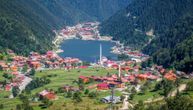Investors supposedly built shelters - and then turned them into garages: Colonel (Ret.) Savic's warning
Only 48 municipalities in Serbia have shelters intended to protect the population in the event of a nuclear war, while the rest do not have this kind of infrastructure.
How will the citizens in those areas be protected? Does reinforced concrete provide sufficient protection from radiation? These questions are answered by civil protection expert, retired Colonel Miodrag Savic, who appeared on K1.
"The number of shelters today is extremely small, which leads us to the key question - why did they stop being built in 2010? According to the previous Defense Law, every investor was under obligation to build shelters. One of the most important permits for the construction of a building was the approval for a shelter. In cases where it was possible to use shelters for blocks (of buildings), the investor was exempted from this obligation, but had to pay two percent of the structure's value to the Shelter Public Enterprise," said Savic.
In 2005, he continued, there was a total of 789,230 places in shelters in the territory of Serbia, of which 236,301 were in Belgrade.
"Today, that number is drastically lower, among other things, because some investors presented shelters as dual-purpose, in order to later turn them into garages, which was allowed at the time. The key problem lies in the fact that today there is no one to build shelters," says this retired colonel.
He believes that the number of shelters would have been higher if the legal obligation had not been abolished:
"What is extremely important is that the shelters must be built in a different way, along with prescribed protection measures and up to higher standards. Shelters must have basic facilities such as toilets and electricity, because mothers with small children, elderly and sick people would go there. Other citizens, depending on their obligations, would be assigned in other ways, either to the army or to their companies".
When we talk about shelters, Savic points out, their basic function is to provide safety for the population in case of biological and chemical hazards, such as warnings of the possibility of the use of nuclear weapons. Such dangers can also occur during peacetime, for example, in the event of a nuclear incident.
There are also standards as to what shelters should be like.
"Shelters must be built according to clearly defined standards, which include location, depth, concrete resistance, airtight doors, air filtration devices, as well as basic equipment such as sleeping pallets and beds. The most important element is the resistance of the shelter, especially when it comes to radiological and chemical protection. Air purification devices are crucial for protection against radiation. There are very clear standards that define these requirements and they must be strictly adhered to. We must bring back the obligation for investors, that while building a building, they must also build a shelter," said Savic.
He added that it is important to raise the level of culture when it comes to reaction in emergency situations, a state of emergency, or an immediate threat of war.
"Citizens should once again be steered towards education. There is enough material regarding fire, flood and impact protection, but we do not have systematic training or an obligation to do carry it out," Savic concluded.
(Telegraf.rs)

